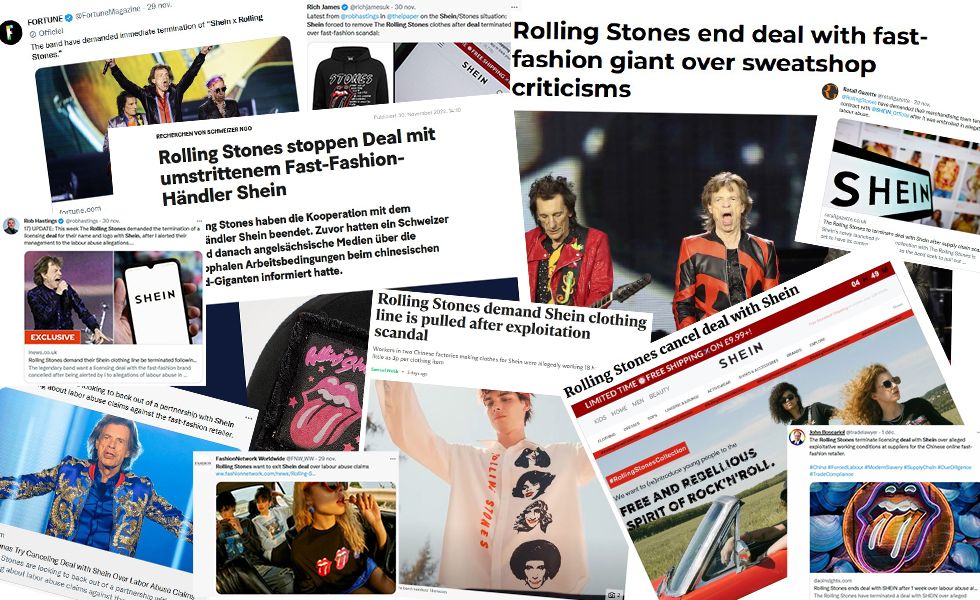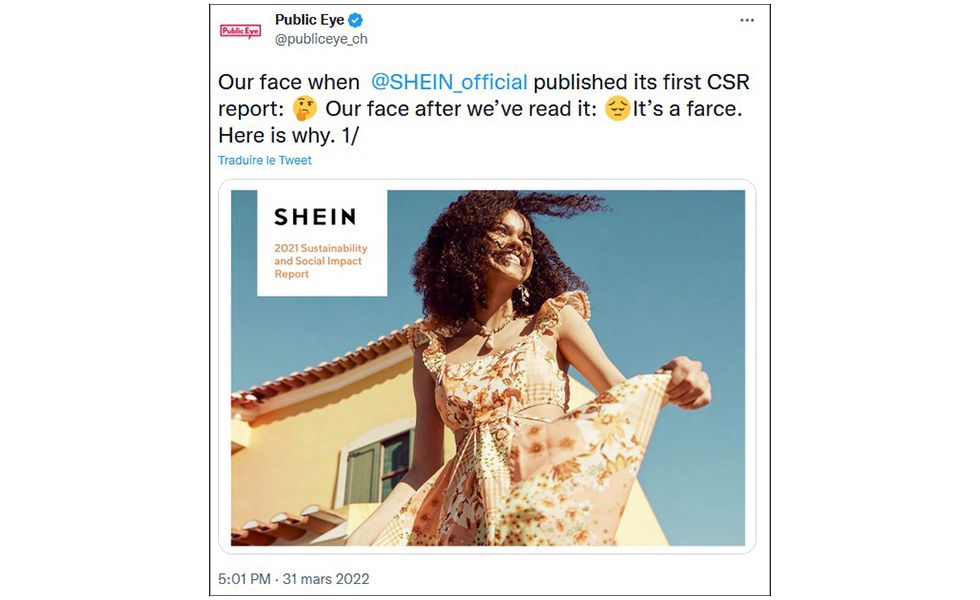PR Platitudes and New Laws: Where is Shein heading?
7th december 2022
Where are the clothes sewn that are hawked for a few dollars in the Shein online shop and tempt thousands from the Tik Tok generation to organise consumer orgies on social networks? Early 2021, together with research partners, we launched a search for clues. It led us to the Chinese metropolis of Guangzhou and to the Belgian city of Liège, to seamstresses who reported on a 12-hour workday with only one day off per month. And to logistics workers who were required to fulfil monstrous quotas for low wages. We published these grievances in Public-Eye-Magazine, as well as in a podcast; the report is now online in six languages, including Japanese.

Global attention on the seamy aspects
Many media followed up on the research, including the BBC and Business of Fashion, RTS, as well as Tagesanzeiger, Repubblica and La Vanguardia. The report even made it onto Swedish children's television, and the results were viewed millions of times on Tik Tok and YouTube, the main channel of Shein's main target group. Süddeutsche Zeitung, Le Monde and Der Spiegel dispatched their own reporters to the production hotspots in Guangzhou we tracked down. Their conversations with workers confirmed our findings. The British Channel 4 even managed to film with hidden camera. Their broadcast in October 2022 triggered a further wave of outrage. Meanwhile, other media investigated aspects we had not yet highlighted. The New York Times interviewed influencers, Wired elicited delicate details about the Shein boss from former business partners and Greenpeace examined Shein clothing for chemicals and concluded that 15% of the samples contained residues exceeding the European limits.
In short, Shein can no longer conceal the seamy side of its business model. Some influencers have withdrawn and recently, in view of the poor working conditions at Shein, even the Rolling Stones cancelled a cooperation agreement with the Chinese company.

Promises instead of improvements
Shein continues to be very tight-lipped with Public Eye. Until today, no replies have been provided to the questionnaire on the research results. The company promised the media that it would conduct a targeted investigation into the allegations. However, possible results and consequences were never disclosed. Only indirectly and four months later, in his first CSR report, Shein admitted that there was space for improvement at 83% of the supplier factories, in particular, in fire protection and emergency exits, as well as regarding the working hours.
Only the workers themselves know whether the situation in the sewing factories has changed in the last year. There is no information and open discussions with workers have become even more difficult. This is also due to the fact that the Garment Manufacturers' Association of the Nancun District, where many Shein factories are located, warned on May 5, 2022, that "groups or foreigners from unknown backgrounds" were conducting interviews and filming under false pretences. It stated that they had published "malicious and untrue comments in the foreign media" which "seriously impacted the social image of the garment industry as a whole." Conspicuities should be reported to the authorities and any interviews are to be coordinated with them in advance.
Nevertheless, local research was conducted once again this year and the results indicate that the grievances uncovered by Public Eye continue to persist or have even become more serious.
Channel 4 reports on workers who occasionally work as long as 18 hours, from 8 o’clock in the morning until 2 o’clock at night. The initial reaction to this publication was similar to the response to previous reports: Shein was "extremely concerned". The company had requested information from Channel 4 and intended to investigate the allegations. Two months later, Shein admitted that the working hours in two of the investigated workshops were indeed in breach of the legal limits. However, the company rejected other allegations as exaggerated or false.
At the same time, however, the statement reveals a completely inadequate response to the problems. The company does not exclude from the wages calculation those portions derived from overtime pay, which compose a large part of the paid salaries. Shein also fails to question the remuneration system, which pays on a piece rate, and which, along with the purchasing practices, is the main reason for the immense work pressure. Furthermore, instead of compensating the workers for the violation of their rights, Shein punishes its suppliers by canceling two thirds of their order volume. This is a doubly devastating signal for those affected: because this cutback has a direct and massive impact on their income, and because they know that next time they have to keep silent if they don’t want to endanger their company and thus their jobs.
New logistics, old problems
New research on ten of Shein´s Chinese logistics centers, no located also in Foshan and Zhaoqing, reveals that the company has now expanded its production base into other regions to meet high demand. According to videos posted mainly by workers on Douyin, China's Tik Tok, 10-14 hour days are also standard there and pay is based on performance (determined by the number of barcode scans).
While everything apparently continues to be the same at the sewing factories and in logistics one year after our coverage, there has been definite movement in one area at Shein: The company has invested heavily in its PR department.
Greenwashing the business model
This headlong rush of communication, however, gives the impression that someone within the corporation has found a 20-year-old manual on sustainability-PR with tips and tricks on how to greenwash the toxic business model.
 ©
Shein
©
Shein
Four weeks after our publication, Shein recruited a global "Head of Sustainability". The signal: sustainability is now a top level issue, we take care of it. And Adam Whinston, a former manager at Disney and JC Penney, performs his new job professionally. He grants only a few interviews repeating there his mantra that Shein is actually very sustainable because they only produce small batches, which results in much less unsold goods and waste than is the case with their competitors. This message subtly distracts from the main problem that Shein's entire marketing is aimed at impulse purchases, many of which are swiftly discarded. The huge mountains of Shein-clothing that remain despite the small quantities and are exported to the Philippines, for example, are also concealed.
Charity instead of Change
Shortly afterwards, Shein launched a charity campaign: over the next few years, a "Shein Cares Fund" shall donate 10 million dollars to NGOs that support disadvantaged groups, animal welfare, recycling or the circular economy. And since that was not sufficient to get rid of the image of a throw-away fashion company, in June 2022, the company announced a donation of 50 million dollars over the next five years to collect garment waste. As partner Shein chose the Or Foundation, which performs various social and environmental projects in Ghana related to the growing textile waste mountains there. The Or Director, of course, immediately appealed to other companies such as Nike, Adidas and H&M to follow Shein's example. The message: Shein acts while their competitors only continue to talk.
No question: the initiatives supported by Shein pursue good causes. And the amounts are considerable, even if they remain within the per mille range in terms of the turnover. It is a daring, but smart PR stunt to keep throwing masses of disposable plastic fashion onto the market, thus earning billions, while using a few millions to buy the image of the charitable disposer of exactly that rubbish.
Everybody has Human Rights Issues, except us
Shein has also invested heavily in its website. The first thing catching the eye under Social Impact is the colourful logo of the Sustainable Development Goals (SDGs). Companies like to adorn themselves with it, because you initially don't have to deliver much: support for the goals and the UN Global Compact, as well as a “sustainability progress report” are sufficient. The one published by Shein in March 2022 is totally meagre, lacking for instants any information on production sites or the quantities of clothing sold. There is also no mention of Shein's problematic purchasing practices, trade union rights or living wages. Nevertheless, it was still sufficient for the pretty SDG logo.

Recently, Shein has even adopted a Human Rights Policy. Here, too, the company focuses on the problems and risks of others. A code of conduct is at the centre of the policy which all business partners must adhere to. Should sporadic inspections reveal irregularities, the suppliers must remedy them or Shein terminates the cooperation. The fact that the far too low prices Shein pays these factories, together with the tight delivery deadlines and the pressure to continuously produce tons of new models, are responsible for many grievances among the business partners is nowhere mentioned in this document. In short: When problems arise, corporate responsibility is outsourced to the suppliers.
However, Shein has pulled even more out of its greenwashing trick bag in 2022. The new special collection EvoluSHEIN, partly composed of recycled polyester, is intended to provide the range with a more sustainable look. And a resale programme encourages Shein customers to resell discarded clothing instead of dumping it. The company has also formulated emission reduction targets. However, the advertised 25% until 2030 is just as meagre as the details of the strategy. Specific problems, such as air freight logistics, are not even addressed.
Actually, many of Shein's projects are small steps in the right direction. But without a change of strategy, away from the throw away fashion and manipulative marketing tricks that result in overconsumption, these are mere fig leaves for a business model that is toxic for humans and the environment.

Rumours of expansion and flotation
Since we last year also examined the structure of the group, a lot has happened. Shein is opening huge new logistics cents in the USA, Canada and Poland, among other locations. A new European boss is supposed to implement new partnerships here. And the company is expanding its production capacities to new regions, not only in China. Shein is currently also recruiting staff to establish a new production centre in Turkey. Does the company intend to shorten delivery times for its customers in Europe and the Middle East or reduce its dependency on China? There is no word from Shein in this regard. There is also nothing about the business statistics on the new website. However, this does not prevent the company from emphasising how committed it is to transparency.
Is Shein really achieving 20 billion dollars in sales in 2022 and is it really worth 100 billion dollars? Or is the company overvalued? This speculation will probably continue until politics or a flotation forces Shein to publish an audited annual report. Rumours regarding an "Initial Public Offering" (IPO) have been circulating for years, but do the owners really want or need this access to the capital market?
Do politics put Shein in his place?
Shein, of all firms, appeals to governments to promote "both transparency in extended supply chains and human rights in all the countries in which we operate". For once, we agree: policymakers must finally force Shein and similar companies to disclose their business figures and practices. The entire supply chains; the working conditions in the production, packaging and sales; the environmental and human rights risks and how they are countered: all this information must finally be made available to the public.
While Swiss politicians continue to sleep on this, an initial legislative project is underway in the EU: the recently adopted Directive on Corporate Sustainability Reporting is intended to make greenwashing more difficult and should also force Shein to provide at least somewhat more concrete information. Unfortunately, also this measure is incomplete and far too late: for companies that, like Shein, sell their products from third countries into the EU, it will not take effect until 2029, and an obligation to disclose supply chains is completely absent. With its textile strategy, the EU also intends to eliminate throwaway fashion and ensure that, as from 2030, all fashion products on the EU market are durable and produced in a socially and environmentally responsible way.
However, substantial specifications are still lacking in many places. Whether and how the advertised EU supply chain law will also force foreign online retailers like Shein to assume more responsibility is still being negotiated. In the USA, too, there are new bills on the table intended to make Shein and other fashion retailers more transparent and accountable.
Shein obviously senses that politicians worldwide are increasing their pressure. In response, the company has already commissioned lobbying firms to pursue and, if necessary, fight the regulatory plans for the clothing industry and online trade.
It is now important that law makers in Berne, Brussels or elsewhere avoid being blinded by further promises, and instead enforce a truly socially and environmentally sustainable fashion industry with binding rules for all.
N.B.: Our esteemed colleague Timo Kollbrunner has meanwhile moved on to Republik. We are grateful for his significant contributions to the Shein report and other research and sincerely hope that he also gets some stones rolling at his new workplace.

